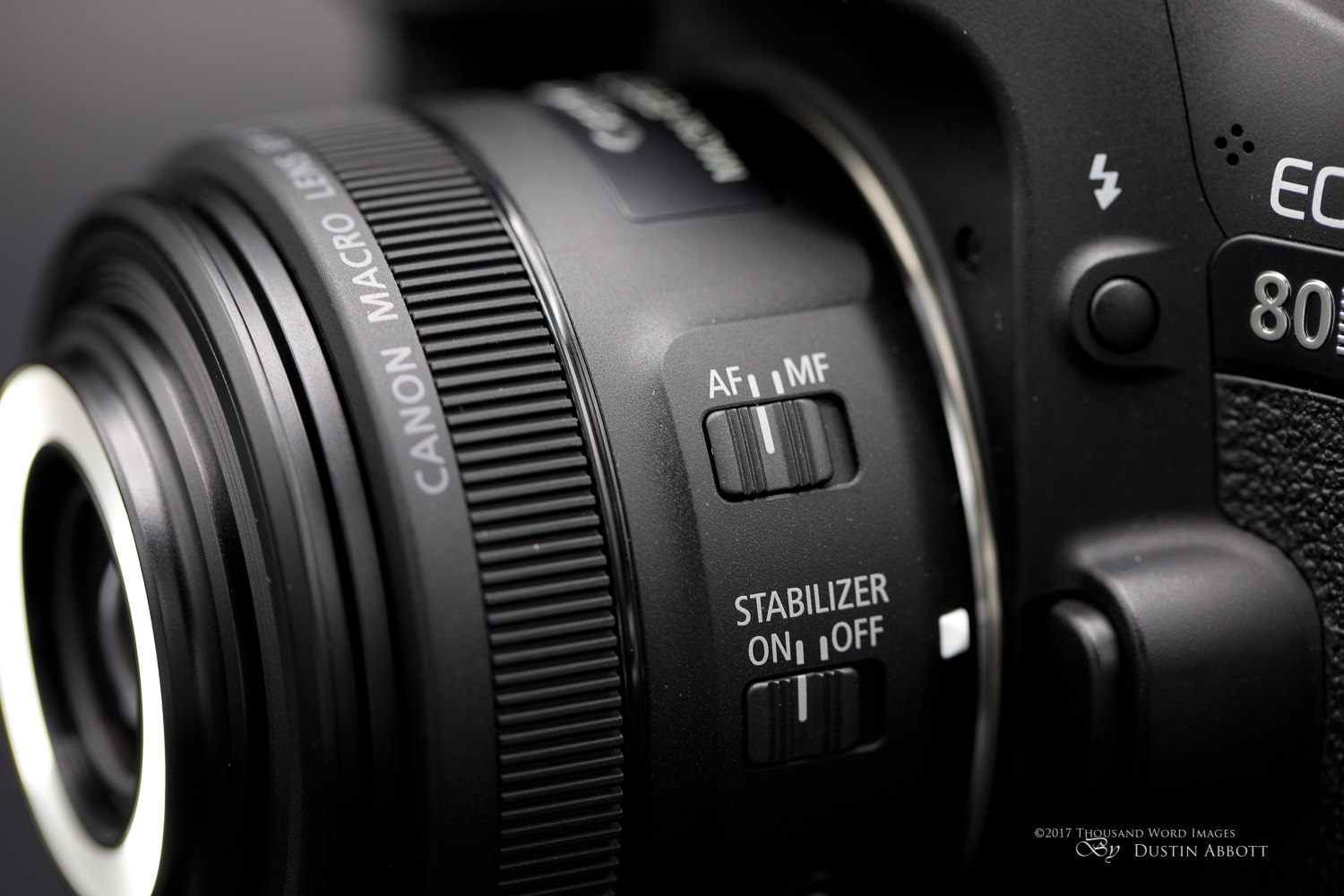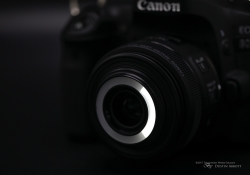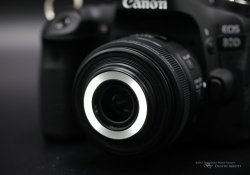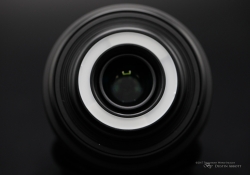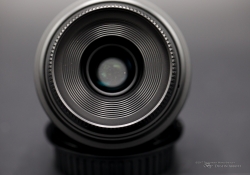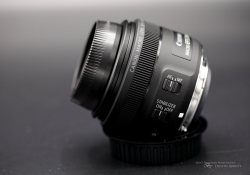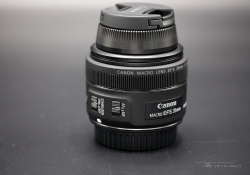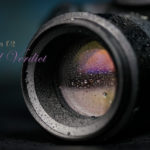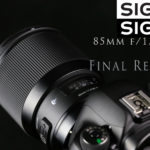Last year Canon introduced a novel concept that might have been lost on a lot of Canon shooters due to it being implemented on a lens for Canon’s mirrorless EOS M system – the EF-M 28mm f/3.5 Macro IS STM that I reviewed here. That concept was a macro lens with a built-in LED ring light to help illuminate subjects. Macro photography is notoriously demanding for light; effective aperture changes at close focus distances (becoming smaller and requiring more light), and, with lenses that can focus so closely, there is often some shadowing of the subject by the lens/camera. Canon introduced an interesting solution to this problem that didn’t require big, bulky external flashes or some other lighting solution in the form of small LED ring lights built into the front of the lens itself on both the right and left sides. The low power draw and flexible nature of LEDs made this viable from an engineering perspective. And it works, at least in a limited way. I was impressed in most ways by the EF-M lens; it was compact, sharp, and versatile. So, when Canon announced this lens – the EF-S 35mm f/2.8 Macro IS STM – I felt it was a natural way to bring this concept to a larger audience. In this review we will explore whether or not the 35 Macro is the lens for you.
Prefer to watch your reviews? I’ve got you covered. See my detailed video review here:
Who is the 35 Macro For?
Before proceeding, let’s first deal with Canon’s existing macro prime lens for the EF-S (APS-C/crop sensor) lens mount (which includes the Rebel/xxD/Kiss line, the XXD line [60/70/80D], and even the 7D series). The EF-S 60mm f/2.8 Macro USM is a more traditional focal length for a macro lens, with a full frame equivalent of 96mm – very similar to Canon’s multiple 100mm full frame macro options. It is a [relatively] older design, introduced in 2005, and is a lens I personally owned for years when I primarily shot APS-C. Since that point, Canon has developed two new priorities that the older 60mm lens is missing. The first is Canon’s “Hybrid IS (Image Stabilization)” that debuted with the Canon EF 100mm f/2.8L IS Macro USM. It was an image stabilization system that was designed to not just cope with camera movement at typical focus distances but also with the unique stresses that macro shooting provides. While no IS system is perfect at macro distances, this made a huge difference in allowing for fairly effective hand-held macro shots (something very difficult with non-stabilized macro lenses). The second, more recent shift is due to the development of Canon’s DPAF focus system (Contrast AF), and, more specifically, the ability to have servo AF (autofocus) during video recording.
Canon’s USM focus motors are great for stills. True ring USM provides a lot of torque for quick, accurate focus. But the nature of the focus system becomes a disadvantage when shooting video. Focus shifts aren’t very smooth, and the focus motor is often noisy, with clicks and pulses that diminish both video and sound quality. Canon developed its STM (stepping motor) technology for this very reason, and it emphasizes smooth focus transitions. STM motors are also much quieter during video focus. Canon has made progress with the speed of focus in its STM motors for stills capture, too.
The 35 Macro includes these modern touches, but in a different type of focal length that is effective for different things. Canon’s press release says this, “The EF-S 35mm f/2.8 Macro IS STM from Canon is a 56mm-equivalent prime lens designed for APS-C-format DSLRs. Offering a life-size 1:1 maximum magnification and a 5.1″ minimum focusing distance, this lens further distinguishes itself with an integrated Macro Lite LED on the front of the lens to provide additional illumination to close-up subjects. Aiding its ability to reproduce small subjects at life size, the optical design incorporates one aspherical element to reduce spherical aberrations in order to provide a high degree of sharpness and clarity.
Benefitting the optical attributes is a Hybrid IS image stabilization system that serves to minimize the appearance of camera shake for sharper results when working handheld and in difficult lighting conditions. A lead screw-type STM stepping motor also benefits handling by producing fast, smooth, and quiet autofocus performance to suit both stills and video applications. This AF motor can be manually overridden at any time by turning the dedicated focusing ring for making fine-tuned adjustments.”
A 96mm equivalent (EF-S 60mm) has different strengths and weaknesses than a 56mm equivalent (EF-S 35mm). I’ll quickly detail those to help you if you are trying to choose which lens suits your needs more. The 60mm lens is a great dual-purpose macro/portrait lens. It is extremely sharp, and the combination of the longer focal length and similar maximum aperture allows you to shoot portraits with the background more blurred (some compression from the longer focal length). It will be the preferred lens for shooting insects or flowers due to being able to have a narrower angle of view (backgrounds less busy) and a little longer working distance (how far you can be from your subject and still fill the frame). Potential downsides will be if you want to shoot video you will definitely find the USM motor detrimental both in the quality of focus and the noise. There are also situations where a longer focal length makes for a less versatile lens for general purpose shooting. If your priorities are mostly stills and you would like the lens to double as an effective portrait lens, then I think the EF-S 60mm Macro is a good choice.
The 35 Macro has different strengths. It is smaller (a half inch shorter at 2.2”/55.8mm vs 2.75”/68.8mm) and lighter (6.7 oz/190g vs 11.8oz/335g). Neither lens is big or heavy, but if you want to travel light, the 35 Macro is the winner (and also will be better suited to using on Canon’s mirrorless (EOS M) via the adapter. It has the STM motor, which will give much quieter, smoother video performance while offering roughly similar speed for stills (in this particular lens). It has built in IS (Image Stabilization), which will make it much easier to shoot hand-held macro and general purpose shots along with being better suited for video. It is roughly $100 cheaper. It also has the built-in LED ring “lite” (Canon speak), which has some value in a limited application. But it is the focal length that may be the biggest point of distinction. The EF-S 60mm is a medium telephoto, with all of the strengths and weaknesses that come with that. The longer focal length and no stabilizer will be more challenging for doing handheld macro but will also provide a field of view too narrow for doing things like food photography in many situations. Even in my Angler Port-a-Cube light tent that I shoot product photography in, I find shooting some products difficult with a longer focal length, and I sometimes use the Tamron 45mm f/1.8 VC in that situation mostly because of the more advantageous focal length. The 35 Macro certainly could fill that role well.
I included this section mostly to give you an opportunity to seriously consider what lens would serve your actual photography needs best. Both are excellent lenses in their own right, but they by nature suit different needs.
Build, Design, and Features
If you have used Canon’s newer 50mm f/1.8 STM lens, then you have a pretty good idea of the build of the 35 Macro. It is extremely lightweight (6.7oz/190g), which is pretty amazing when you consider that this is a full 1:1 macro lens, has IS, and also has the built in LED lights. Like the 50mm f/1.8 STM, it feels fairly “plasticky”. Like that lens it shares a matte-type finish. The lens mount appears to be metal but, if so, is an extremely lightweight one. As noted, the lens is really quite compact. It has two switches on the side of the barrel (AF/MF and ON/OFF for the IS system). There is also a small button for enabling the built in LED lights, which we will examine more closely in a moment. Finally, there is a single ring closer to the front of the barrel for manual focus. Since this is an STM lens it lacks any kind of distance window or distance markings.
STM Observations
On that note: STM lenses are really designed primarily around autofocus, and, of course, for many people, that’s all they need. But when you need to manually focus (which is a more common occurrence with macro lenses), STM lenses number among my least favorite to manually focus. Why? Because STM employs a “focus by wire” manual focus system, where input from the MF ring is routed through the focus motor and it is the focus motor that actually moves the elements. This requires the camera to be on and not in sleep mode, and while you have full time manual override, the shutter button must be half depressed before it will recognize any input. You would be surprised how many times I’ve had people ask me if their lens is broken for the simple reason that when they turn the MF ring nothing is happening. Even when you know how the system works, however, the focus-by-wire system still disappoints, as there is both some input lag that makes fine tuning (crucial for macro) frustrating at times and also because there is no real tactile input from the focus ring, which essentially just endlessly turns. STM implementation has improved somewhat, but it still is far from perfect.
Those using one of Canon’s more recent DSLR’s that include their excellent touchscreen will have the best experience, as using Live View focus and the touchscreen allows one to select a focus area without being concerned if an AF point is on it. Magnifying the image gives you even more finite control. Still, hardcore macro shooters (focus stackers, for example), might prefer a different macro option.
On a positive note, while STM originally prioritized smoothness of focus over speed, this lens actually focuses very quickly. Canon calls this a “lead screw type STM”, which indicates to me that there are a few different approaches to STM and might be the reason that recent STM lenses have had greater focus speed. It’s impressive, actually, when one considers how much bigger the focus range is for a lens that can focus down to just a few inches (5.1″ from the sensor!). I found that I could go from macro range, bring the camera up, and shoot towards infinity with very little focus lag at all. The lens lacks any kind of focus limiter, so being able to quickly “rack” focus is definitely important. The smoothness and quiet focusing of the STM motor also makes it an excellent option for video work.
I had zero complaints about autofocus accuracy, too. The lens snapped on focus confidently and accurately, and I didn’t really see any focus misses during my review period. This shot, for example, shows the excellent focus accuracy of the lens:
On my canon EOS 80D test body the copy I reviewed required no focus calibration at all, which is somewhat rare in my experience. So, outside of my continued disappointment with the nature of STM lenses for manual focus, I was generally very pleased with the autofocus performance of the lens.
Hybrid IS and LED “Lites”
Starting with the Canon EF 100mm f/2.8L Macro IS (a lens I own and love) Canon began implementing a new type of IS (Image Stabilization) system for macro lenses (and a few others with very close focus abilities). Macro distances require greater precision, as effective apertures close, light often diminishes, and any kind of blur occupies many more pixels due to the close focus. Macro work basically required the use of a tripod (and, to be fair, a tripod still produces the best results). But Canon’s hybrid IS system was designed to not only compensate for camera shake at normal distances but also the unique types of movement often associated with macro work. As a result, it became much easier to do handheld macro shots. This lens in some ways makes it even easier due to the shorter focal length. The IS system is quite effective in all settings, from normal distance to macro to video work. It is extremely quiet and unobtrusive, with no jerking during on/off transitions and no obvious noises that would impact video. Combine this with one of Canon’s newest bodies that offers in body image stabilization during video work and you could get nicely clean results.
The most relevant metric for me with a lens like this is whether or not I can get good macro results “on the fly”, and this handheld photo is evidence that you certainly can with the 35 Macro.
The key feature for this lens is the built in “Macro Lite” LEDs. Take a look at this video for a closer look.
From Canon, “Built-in front-facing Macro Lite LED can be used to produce additional illumination to subjects when working at close distances. The light can be configured to illuminate only the right or left side, or both sides, and the brightness can be adjusted in order to produce greater visual depth and reduce shadows caused by the close proximity of the lens to the subject.” There are essentially six options (other than off) for the lighting. There are two brightness options with both lights illuminated (they form a shape like this ( ) on either side of the front element). You can also choose to select either side alone at either of the two brightness levels.
It’s important to have realistic expectations for the amount of light coming from “Macro Lites”, as they are really designed around a specific purpose. At portrait distances they will make almost no difference at all. Canon doesn’t provide a rating, but the amount of light will not make much of a difference at any distance beyond about three feet. Look at the comparisons at several different focus distances – this is with the lights in their brightest mode. The comparison images are with the light turned off.
This comparison shows the difference between the two light settings:
I’ve mentioned the challenges associated with macro shooting and light. Physics means that less light reaches the sensor anyway at macro distances, but there’s also a strong possibility of the camera/lens combo also shading your subject due to the extremely close focus distance (at minimum focus distance the subject is no more than 2 inches from the end of this lens, as the minimum focus distance of 5.12″/13cm is measured from the camera’s sensor, not the end of the lens). This is where the built in lighting system is really effective. It gives you back some of the lost light at macro distances, and with some control over the output and even direction of the light by allowing you to power only one side light if desired. I particularly find this helpful for doing quick, hand-held macro work. More light equals a faster shutter speed which in turn means less chance for your image to be negatively impacted by motion blur. Here’s an image that was helped by utilizing the Macro Lites:
I think you will be pleased with the difference these lights can make as long as you have realistic expectations. In certain situations they can make a very positive difference. Watch out for situations where you have a shiny, reflective surface, however, as since they are fixed into the lens there is no opportunity to position them in such a way to minimize reflections.
The addition of the built in LED lights means that there isn’t room for traditional filter threads on the 35 Macro. Canon solves this by including a “lens hood” (ES-27) that is really more of an adapter to add filter threads in a 49mm size. It screws in at the front of the lens and will provide a [very] small amount of shading from external light but primarily serves to allow you to use filters. Note that this is an either/or thing, as the adapter will cover the LED lights and you will not be able to use both filters and the lights. The adapter is shaped somewhat like a rear lens cap, which gives the lens an unusual profile when attached. It’s a functional solution to the problem of not having traditional filter threads on the front of the lens, but the other obvious downside is that you have to remember to bring it along.
I’ve now used two lenses from Canon with this approach to adding light to macro situations, and I do feel that the “Macro Lites” are more than a gimmick as long as you use them within the limited scope of their effectiveness.
35 Macro Image Quality
Macro lenses by nature tend to be very sharp lenses (resolving fine details at macro distances requires it), and the 35 Macro is no exception. If you would like to see a detailed visual breakdown of the image quality, watch this video:
I compared it to the sharpest 35mm lens that I’ve ever used, the Canon EF 35mm f/1.4L II, and when I shot them at equivalent apertures (the 35L II is stopped down two full stops at f/2.8 and is entering optimal performance) I was pleasantly surprised to find the inexpensive 35 Macro reasonably held its own. In the center the full frame lens showed a little more contrast, but resolution was fairly close. At the edges of the frame that 35L II was definitely the stronger of the two. Here’s a look at the f/2.8 comparison with crops from across the frame.
With both lenses stopped down to f/4, however, the gap closed, and the 35L II’s advantage in the extreme corners was smaller, and, by f/5.6, they delivered roughly equal performance.
In real world shooting I saw plenty of detail in images at all focus distances. This is one of the sharpest EF-S lenses that Canon has made.
I was also pleased with other areas of lens performance. I saw very little chromatic aberration in field conditions, making that essentially a non-factor for your work.
Flare resistance was also quite good, with minimal amounts of ghosting and/or veiling.
While testing for this I also found that the seven-bladed aperture produced a sunburst effect that I consider quite exceptional. Very artistically usefully for adding an extra touch to images!
I found that images had very nice contrast and color rendition at all aperture values, making this a versatile lens for shooting in a variety of conditions. Combine this with very pleasing bokeh rendering and you have a lens with the potential for creating a lot of beautiful images.
While the quality of the bokeh is excellent at all focus distances, the potential for creating a lot of background blur is limited by the combination of a relatively short focal length (35mm or 56mm FF equivalency) and a moderately wide maximum aperture (f/2.8). At close focus distances you can easily blur out the background:
But if you move back just a foot or two, the background blur really diminishes, leaving the potential for busyness:
It also limits the options for shooting portraits. At a distance of around twelve feet (roughly 4 meters), there is little blurring of the background even at f/2.8 in this quick portrait of my son. The quality of the blur that is there is good, but there isn’t much of it. This is where a longer focal length would be handy to allow for a more defocused background.
The lens does have some vignette at f/2.8, but it is mostly cleared up by f/4.
Distortion is quite well controlled, with only the smallest hint of barrel distortion. This should be a straight line – and it basically is:
All in all the optical performance from the lens is excellent, particularly when one considers its relatively inexpensive price point. I recommend that you take a look at the Image Galleries for more samples that I’ve taken.
Conclusion
From the reaction (or lack thereof) to this lens (and my coverage) on my social media and YouTube channels, I can surmise that this lens is “flying under the radar” compared to other high profile lenses and cameras it is competing in press coverage for. It’s a shame, as this one of Canon’s better EF-S lens releases. The compact size and light weight of the 35 Macro make it a very nice option for the Rebel and SL lines, and I think it is worthy of consideration for those who own one of Canon’s mirrorless options, too. The build quality feels somewhat “plasticky”, but that too contributes to the light weight. Everything works as it should, with speedy (and accurate) autofocus, excellent image quality, and genuine usefulness. The greatest downsides to a lens like this (in my opinion) are really the limitations of this focus length and maximum aperture, which essentially require you to be very close to your subject to generate much blurring of the background. The “Macro Lites” are also useful, but within that same limited proximity to your subject. The Hybrid IS system allows for fairly effective handheld macro and will also increase the usefulness of this lens for video work. The Canon EF-S 35mm Macro f/2.8 IS STM is also reasonably priced ($349 in the US Market), making it an easy pick if the nature of the lens suits your needs. If you are looking for a “normal” focal length lens that also doubles as an excellent 1:1 macro lens, then look no further – the 35mm Macro IS lens is what you’ve been looking for!
Pros:
- Excellent image quality at all apertures
- Good contrast and color rendition
- Nice quality of bokeh
- Autofocus is speedy and accurate
- Hybrid IS system works effectively and quietly
- Macro Lites are useful when used within their limits
Cons:
- STM manual focus action isn’t as precise…and macro shooters like to manually focus
- Potential for creating background blur is limited
- Build quality feels cheap
- Macro Lites have limited range
Gear Used:
Canon EOS 80D: B&H Photo | Amazon.com | Amazon.ca |
Canon EF-S 35mm f/2.8 Macro IS: B&H Photo | Amazon.com | Amazon.ca
Adobe Lightroom CC Software for Mac and Windows (Boxed Version)
Adobe Photoshop Creative Cloud 1-Year Subscription
Alien Skin Exposure X2 (Use Code “dustinabbott” to get 10% anything and everything)
Purchasing your gear through B&H and these links helps fund this website and keeps the articles coming. You can also make a donation here if you would like. Thank you for your support.
Great News! I can now offer a 5% discount on all purchases at Amplis Foto, Canada’s Leading Photographic Supplier. Please enter discount code: AMPLIS52018DA in your cart. It is good for everything in your cart, and is stackable with other coupons, too! It will take 5% off your entire order! Proceeds go towards keeping this site going and providing you with new reviews!
Check me out on:
My Patreon: | Google+: | Facebook: | Twitter: | Flickr: | 500px: | Sign Up for My Newsletter :


Travel Banner:




